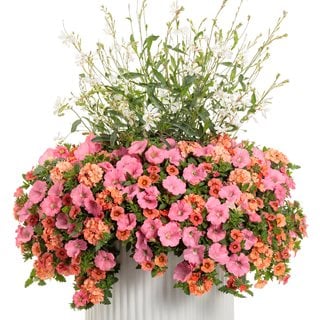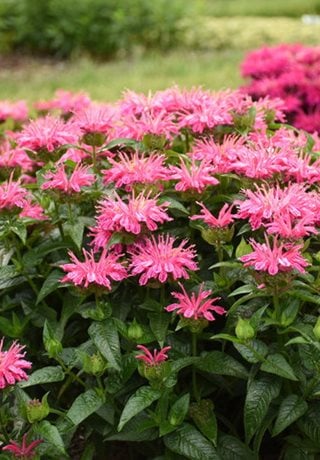HOW TO GROW & CARE FOR GAURA PLANTS
Gaura adds texture, movement, and long-lasting color to the summer landscape
Stratosphere™ Pink Picotee gaura. Photo: Proven Winners
Gaura is a native perennial with an open airy habit, four-petaled pink or white flowers, and narrow lance-shaped foliage. The elegant blooms are produced on long, slender stems that move in the slightest breeze, resembling a cloud of fluttering butterflies. This delightful ornamental plant adds fine texture, movement and structure to beds, borders and containers. Flowers are produced for months during the growing season, attracting hummingbirds, butterflies, and a range of insect pollinators.
Native to grasslands and prairies of Texas, Louisiana, and northern Mexico, Gaura is carefree and tolerant of heat, drought, and humidity. Plants develop a deep carrot-like taproot that allows them to survive extended periods of drought. Here’s how to grow and use gaura in your landscape.
On this page: Basics | Planting | Care | Pictures | Frequently Asked Questions | Landscaping Ideas
On this page:
GAURA BASICS
Botanical name:
Oenothera lindheimeri, syn. Gaura lindheimeri, Oenothera gaura
Common names:
Gaura, appleblossom, beeblossom, butterfly flower, butterfly gaura, Indian feather, Lindheimer’s beeblossom, Lindheimer’s clockweed, Lindheimer’s gaura, wandflower, whirling butterflies
Plant type:
Herbaceous perennial, also grown as an annual
Zones:
5-10
Exposure:
Full sun to part sun
Habit:
Open airy growth habit, with a bushy or vase shape
Height/Spread:
1 to 4 feet tall and wide
Bloom time:
Late spring to fall. The heaviest flowering occurs in early summer, with flushes of rebloom into fall.
Flowers:
Pink or white four-petaled flowers resemble butterflies. The small one-inch flowers occur a few at a time on slender upright stems throughout the bloom season. The flowers are a rich source of nectar for butterflies, bees, and other insect pollinators.
Stems:
Thin, wiry, upright stems produce leaves at the base, becoming leafless towards the top where the flowers are produced. Stem coloring can be green, red, or burgundy.
Foliage:
Narrow lance-shaped deciduous leaves are green, mottled, burgundy or variegated.
Toxicity:
The ASPCA lists gaura plant as non-toxic to dogs, cats, and horses. Animals may experience some minor digestive upset if any plants are ingested.
Is gaura deer resistant?
Gaura is considered deer resistant, though deer will graze on almost any plant if they are hungry enough.
HOW TO PLANT GAURA
When to plant:
Gaura can be grown from seed or nursery starts. Plant when all danger of frost is past. Varieties grown as an annual should be planted in spring. Perennial varieties can be planted in spring or fall in warmer zones, and are best planted in spring in cooler regions to allow time to become established.
Where to plant:
Choose a site with at least 6 hours of direct sunlight and sandy or loamy soil with good drainage. Plants will benefit from some afternoon shade in hotter climates. Too much shade will cause plants to become lanky and flop. Established plants are difficult to transplant due to the deep carrot-like taproot, so choose a permanent site where it can remain undisturbed.
How to plant:
Loosen soil in the planting area to at least 12 inches to accommodate the deep taproots. Amend soil with compost or other organic matter, making sure there is good drainage. Dig a hole twice as wide and the same depth as the root ball. Remove the plant from its nursery pot and gently loosen roots if potbound. Place plant in the hole so the top of the root ball is level with the surrounding soil. Fill in soil around the root ball, gently tamp down, and water well to remove air pockets. Space plants 2 to 3 feet apart.
GAURA CARE

Container with Stratosphere™ White gaura, Superbells® Coralina calibrachoa, Supertunia® Bermuda Beach® petunia, and Superbena® Peachy Keen verbena. Photo: Proven Winners
Soil:
Gaura prefers lean, sandy soil with a slightly acidic to slightly alkaline pH of 6.1-7.8. Plants are tolerant of poor soil as long as it drains well. Sharp drainage is essential for plants to successfully overwinter. Poor drainage can lead to root rot. Soil that is too rich may cause plants to flop.
For containers, use a high-quality, all-purpose potting soil. Perlite or vermiculite can be added to potting soil to improve drainage.
Amendments & fertilizer:
Gaura does best with little or no supplemental fertilizer. Over-fertilizing may cause plants to produce leggy growth and flop.
Watering:
Plants prefer moderate moisture. Water regularly until established, then thoroughly but less frequently to encourage the taproot to grow deeply into the soil. Overwatering can lead to root rot. Gaura is drought tolerant once established. Water when the top 2 to 3 inches of soil is dry.
Pests and diseases:
When grown in the right conditions, gaura is resistant to most pests and diseases. Pests can include aphids, flea beetles, leaf miners, spider mites and whiteflies. Diseases include leaf spot, powdery mildew, root rot, and rust.
GAURA VARIETIES
FREQUENTLY ASKED QUESTIONS
Does gaura come back every year?
Gaura is a short-lived herbaceous perennial. Good drainage is essential for plants to overwinter. In colder regions, gaura can be grown as an annual.
Do gaura plants attract hummingbirds?
Gaura flowers are attractive to hummingbirds, which feed on the rich nectar.
Should I cut back gaura?
In early spring, remove any dead, diseased or damaged growth and shape plants as needed. Gaura plants can be cut back by up to half their size to stimulate fresh new growth. In mid-summer after the first flush of blooms, cut back spent flower stems and leggy growth to encourage new flowers and a neater appearance. Avoid removing more than a third of the growth.
Does gaura spread?
Gaura may spread through self-seeding, though it is not considered aggressive, invasive or uncontrollable.
GAURA LANDSCAPING TIPS

Container recipe with Angelface® Super Blue angelonia, Superbells® Plum calibrachoa, Sweet Caroline Raven™ sweet potato vine, and Karalee® Petite Pink gaura. Photo: Proven Winners
For borders and landscapes:
Gaura can be planted in a waterwise border, xeriscape, native landscape, meadow garden, or rock garden.
For slopes and hillsides:
Gaura will benefit from the drainage that a slope or hillside provides. Mass gaura plants so their deep taproot system can help stabilize the soil and stem erosion.
For containers:
Gaura can be planted in containers by itself or in combination with other plants with similar growing needs. Provide a pot that is at least 12 inches deep to accommodate the deep taproot. Make sure containers have adequate drainage holes.
Here are some creative ideas on how to use gaura in your landscape:
- Plant large drifts of gaura in a naturalistic meadow garden to appreciate the movement of the dancing flowers waving in the breeze.
- Site gaura in a mixed border between plants with similar growing needs such as lavender, salvia, globe thistle or rosemary to help keep gaura plants from flopping.
- Add gaura to a cottage-style garden where the loose, informal growth habit will complement other cottage-style plants.
- Include gaura in a native wildflower garden for an easy-care landscape that will support beneficial pollinators and other wildlife.
- Plant gaura in a container by itself as a showy focal point, or in combination with other plants with similar growing needs.
- Include gaura in a rock garden to provide weeks of continuous color.
- Gaura can be planted alongside other tough drought-tolerant plants in a waterwise curbside strip that requires little maintenance or supplemental water.
- Add gaura to deep containers and display where the graceful flowers will sway in a gentle breeze.
- Mass along a slope where the deep taproot system will help control erosion.
Companion plants: Many different plants with similar growing needs complement gaura. These include agave, aster, black-eyed Susan, coneflower, eryngium, gaillardia, lamb’s ear, lavender, liatris, ornamental grasses, potentilla, rock rose, rosemary, Russian sage, salvia, sedum, verbena, wormwood (Artemisia), and yarrow.
RELATED:
Growing Shasta Daisies
Cottage Garden Design Ideas
More Popular Perennials










